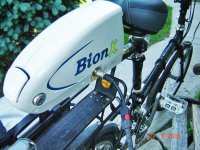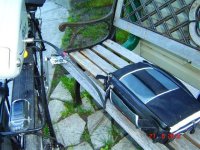GCinDC
100 MW
Wow, awesome information. I've been studying it for an hour here.... 
Do you get increased speed and/or torque with the additional pack? Or is it just increased range?
Also, when you reconnect the lipo pack to the bionx, won't there be current flow between the packs to balance out any difference in voltage?
If the charger limits amps, my plan is hosed -- I've been planning to parallel a 7s 5p (11Ah) lipo pack without a BMS by connecting it to the BionX + & - leads AND charge it ONLY with the BionX charger.
My logic to think I could is:
- Once the packs are paralleled, they'll balance each other
- Since they're paralleled, the voltage will be the same for 'each' pack
- The lipo won't be isolated, so it will accept charge (& regen) current
- The charger will shut off when the pack reaches the voltage, so it'll just take twice as long to charge a pack that's twice as big
Think it will work? Any suggestions?
I'm not crazy about pumping the lipos up to 4.2, even though I will balance them via the balance taps.
I was going to do 8s but thought that'd cause me more problems...
And I was originally going to test a 6.6Ah 8s lipo pack, but decided it'd be better to duplicate capacity as much as possible, so ordered 5 3s 2200mah lipo packs to connect in series with 5 4s 2200mah packs ($175)
Oh yeah, so did you cut the big black & red wires going to the PCBA and splice in a connecting wire to the lipo leads? Or did actually solder the lipo connecting wires to the same spot on the board?
And, on my image on page 1, the yellow charge wire going from board to the pack, does it just go to the - side of the pack, where the black must be soldered?
Do you get increased speed and/or torque with the additional pack? Or is it just increased range?
Any idea how it monitors the energy input? The actual Amps/Ah or the voltage?Since both packs' output + and - are tied together, they are paralleled as one big pack in terms of capacity. The difference is the charge input. Bionx's controller monitors the energy input so the fuel gauge will show full when charging is complete vs the un-monitored Lipo pack.
Also, when you reconnect the lipo pack to the bionx, won't there be current flow between the packs to balance out any difference in voltage?
If the charger limits amps, my plan is hosed -- I've been planning to parallel a 7s 5p (11Ah) lipo pack without a BMS by connecting it to the BionX + & - leads AND charge it ONLY with the BionX charger.
My logic to think I could is:
- Once the packs are paralleled, they'll balance each other
- Since they're paralleled, the voltage will be the same for 'each' pack
- The lipo won't be isolated, so it will accept charge (& regen) current
- The charger will shut off when the pack reaches the voltage, so it'll just take twice as long to charge a pack that's twice as big
Think it will work? Any suggestions?
I'm not crazy about pumping the lipos up to 4.2, even though I will balance them via the balance taps.
I was going to do 8s but thought that'd cause me more problems...
And I was originally going to test a 6.6Ah 8s lipo pack, but decided it'd be better to duplicate capacity as much as possible, so ordered 5 3s 2200mah lipo packs to connect in series with 5 4s 2200mah packs ($175)
Oh yeah, so did you cut the big black & red wires going to the PCBA and splice in a connecting wire to the lipo leads? Or did actually solder the lipo connecting wires to the same spot on the board?
And, on my image on page 1, the yellow charge wire going from board to the pack, does it just go to the - side of the pack, where the black must be soldered?




![Neutrik-4pin-male-RAngle [800x600].jpg Neutrik-4pin-male-RAngle [800x600].jpg](https://endless-sphere.com/sphere/data/attachments/23/23544-1f72d23097f8f600c78f29a0c55d0d27.jpg)
![XLR-adptor [800x600].jpg](/sphere/data/attachments/23/23545-8a06c19d79d9337d97b6b5ab684d781f.jpg)